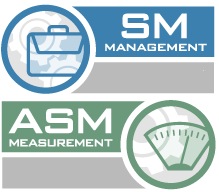SM/ASM 2000 - Software Management & Applications of Software Measurement

PRESENTATIONS
|
A Comparison of IBM's and Hewlett Packard's Defect Classification
In this presentation, Jon Huber examines metrics obtained from categorizing the same set of defects using both IBM's Orthogonal Defect Classification and Hewlett Packard's Origins, Types, and Modes. Learn the pros and cons of each model, and how to apply the strengths from both models to create a method beneficial to software development and testing. |
|
|
Adaptive Software Development
Adaptive Software Development (ASD) is targeted for software teams where competition creates extreme pressure on the delivery process. Many process improvement techniques (CMM, ISO) are focused on optimizing practices that involve steadily increasing rigor. In contrast, ASD emphasizes producing high-value results based on rapid adaptation to both external and internal events. Listen as Jim Highsmith explains how the focal point of ASD is fundamentally different from traditional software process improvement approaches. |
|
|
An Incremental Approach to Setting Up a Data Warehouse
With the growing popularity of agile methods like eXtreme Programming and the emergence of automated, open source unit testing frameworks such as JUnit, the idea that developers should actively participate in testing their own code finally is gaining broad acceptance. Numerous studies and countless examples show the tremendous benefits of having a suite of unit tests created by developers and always executed before integrating units into a build. |
|
|
Benefits from Implementing a Process Improvement Program
Faced with stiff competition and declining budgets, many organizations must determine what they expect in return on investment (ROI) from implementing a process improvement program. In this presentation, you will explore the need to baseline your activities and begin a measurement program at the start of your process improvement activities. Learn some of the basic measurements and metrics used at Hill AFB in their own software development activities. |
|
|
Changing the Software Culture
Many of software's current problems stem from the pervasive culture of software organizations. This "hacker" culture glorifies rapid coding, is schedule-driven, and objects to measurement and planning. Commitments are generally missed while quality is unmeasured and unmanaged. In this presentation, Watts Humphrey describes steps to change the current software culture and its consequences. Learn how the Personal Software Process (PSP) and Team Software Process (TSP) guide engineers in planning and measuring their work. |
|
|
Critical Components of Asset Management
Examine how Information Technology (IT) asset management methodologies can reduce your organization's IT budget between five and thirty-five percent. Kathy Shoop discusses the critical components to deploy, the challenges of implementing such a program, and the limitations of asset management tools such as spreadsheets and in-house development efforts. Discover the best practices for implementing an asset management initiative in your organization that will result in immediate cost savings. |
|
|
Cross-Organizational Change Management
The phrase "test plan" means different things to different people. There is even more disagreement about what makes one test plan better than another one. Bernie Berger makes the case for using multi-dimensional measurements to evaluate the goodness of test plans. Walk away with a practical technique to systematically evaluate any complex structure such as a test plan. Learn how to qualitatively measure multiple dimensions of test planning and gain a context-neutral framework for ranking each dimension. |
|
|
Design and Test of Large-Scale Systems
Increasing complexity and functionality of digital systems--coupled with time-to-market constraints--pose quality challenges. Strategies often include a mix of new development with the integration of pre-existing components from multiple sources. Ann Miller presents some of the software engineering and software management lessons learned from eight years on a large commercial satellite program, as well as several years on military satellite programs. |
|
|
Establishing a SEI Capability Maturity Model Level 3 Metrics Program--And Living to Tell About It
Metrics are foundational to CMM Levels 3, 4, and 5. However, introducing all of the metrics required by CMM Level 3 into your organization can seem like an insurmountable task. Examine a case study of the development and deployment of a successful CMM Level 3 metrics program. Learn about each major Level 3 metrics requirement and obtain examples on how they can be addressed. |
|
|
Estimating and Tracking Software Size without Lines of Code or Function Points
Sandee Guidry explains the processes that were used to effectively manage projects at Defense Financial Accounting System (DFAS). This presentation walks you through the process from when project requests are originated, through the analysis of requirements, the development of estimates, etc., to the delivery of the final project. Learn estimation methods and tools that were seamlessly integrated to deliver each project's committed functionality -- on time and on budget. |
|


